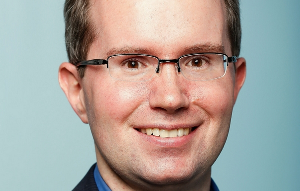Transformation. It's something that most organizations are striving for right now as they aim to evolve beyond legacy infrastructure and forge the future of their businesses with a digital-first philosophy. Those who achieve such a transformation may find themselves feeling transformed in more ways than they expected.
Dr. David Bray, senior executive and CIO of the U.S. Federal Communications Commission, recently led a team that completed a two-year transformation journey dubbed “Operation Server Lift,” which involved a massive overhaul of how the organization approached technology and rapid adoption of cloud-based platforms. Six months later, we caught up with Bray to find out how the ripple effects of that transformation have changed his organization – ranging from how his team functions to the intentional word choices they use to describe their new roles.

The Enterprisers Project (TEP): What are some of the changes you are seeing within your organization since the modernization efforts and journey to cloud-based services?
 Bray: We recently renamed and refocused our different teams of people. Though this may seem semantic, words matter, and this refocusing effort indicates how much we've fundamentally changed as an organization.
Bray: We recently renamed and refocused our different teams of people. Though this may seem semantic, words matter, and this refocusing effort indicates how much we've fundamentally changed as an organization.
For example, team members focused on what used to be called “engineering” and “enterprise architecture” now will be working together on “cloud integration and catalog.” These team members now produce a catalog of the different services and modules that are available to us on the commercial cloud platforms. Think of these cloud-based services and modules as being pieces of fabric that you can “stitch together” like a quilt in different ways. That’s a dramatic change from how we used to operate on-premise in the past.
TEP: Can you explain how this modular approach to reusing cloud-based services differs from the previous role of enterprise architecture?
Bray: Custom solutions are costly to build and expensive to maintain, which is why we eventually had to do Operation Server Lift. Comparatively, we can integrate modular commercial cloud services to produce enterprise-grade solutions at a much faster speed than before. When a bureau or office comes to us with a new need – perhaps it’s something requiring user authentication, data collection, data visualization, and some mapping of results – we can now look in our catalog of cloud services and rapidly “stitch together” a new solution using APIs and minimal custom code. For example, we were recently able to produce a working cloud-based prototype for a bureau in less than 48 hours using commercial cloud solutions.
Since almost all of these modular cloud-based services are either fixed price or consumption based, we can work with the bureau or office to identify the necessary funds and produce an enterprise-grade prototype for them at a fraction of the time it would take to write custom code or procure a new solution.
TEP: Have these changes also impacted how you do solutions development?
Bray: Yes, the team members that used to do “systems development” or “solutions development” are now focused on doing “tailored platform and data.” We are shifting away from being application-centric and becoming data-centric. Data is core to everything the FCC does. By reusing what these commercial vendors provide, we are able to focus on the core mission of the FCC, rather than write custom code that will be expensive to maintain in the long-term. This team is now essentially tailoring cloud-based platforms to meet our needs.
This modular approach to building solutions also allows us to shop around for the best solution. Specifically, if other vendors come out with a better cloud-based user authentication module, a better data visualization module, or a better mapping of results services, we can change the preferred module for that type of function in our service catalog. As a result, we can update the modular service across the enterprise without having to completely overhaul all the different cloud-based systems.
How the new teams work
TEP: How do these teams now interact both internally in IT and with the larger FCC organization?
Bray: It helps to think of an analogy of highway, car, and driver. The team members who do cloud integration and catalog are the ones who set up the highway. Using cloud-based services procured from different cloud vendors, these team members set the boundaries for the road, the direction of flow, put up the signage, etc. They are the “highway” folks.
The team members who do tailored platform and data are the ones who work with the offices on their specific digital needs. Continuing the highway analogy, these team members help our partners pick the right car or truck or motorcycle to drive on the bounded highway. Depending on their specific needs, our partners in the offices may need a two-seater or four-seater, or a motorcycle with a sidecar, or a Jeep. Whatever it is, we tailor the cloud-based platforms and data to meet the specific needs – while at the same time we strive to avoid too much customization or custom code that will be costly for the enterprise to maintain in the future.
Finally, the offices can then be the drivers using the car and the highway provided. Within the interface of the cloud solution, if they want to design new reports, change the UI, or create new forms they can do so. Some cloud-based services are a firm-fixed priced and others are consumption-based. So we also give the drivers, our internal partners, the equivalent of a “gas card” that’s linked to their budget. They can drive wherever they want using the integrated cloud solution provided to them.
We already have had success with this “drive where you want with a gas card” approach for partners wanting to do electronic discovery across massive amounts of documents via a cloud-based solution. Each office achieves visibility into how much “fuel” they have to spend – say, $125,000 worth of consumption – and it is now a shared responsibility to ensure this fuel is metered appropriately instead of coming back and saying, “By the way, I drove back and forth across the country 10 times, and now I’m out of gas.” This overall approach also empowers the partners to make quick updates to cloud-based services.
Moving forward with a new sense of purpose
TEP: Do you find that the new focus changes people’s perceptions?
Bray: Yes, there’s an intentional narrative with our new focus and word choices. In some respects, this new model of cloud-based solutions represents the capstone of all our efforts – empowering the offices to move with speed and freedom from costly legacy systems. When we completed Operation Server Lift, the leadership team took time to reflect and decided, “Okay, what was once on-premise engineering and enterprise architecture no longer fit our new model of cloud-based solutions.” We give thanks for everything these teams did for the on-premise model over the last 15 years, and now we need a new focus and a new sense of purpose for how these teams will produce solutions for organization going forward.
In my discussions with other organizations – both public and private – I have heard similar stories to what ours at the FCC was “pre-modernization:” hundreds of legacy systems, lack of coordination across the enterprise, and an urgent need to move to cloud-based solutions that are much more scalable and resilient. Having moved everything off-premise and intentionally focusing on cloud integration, catalog, tailored platform and data, we hope this new model will serve us well for the next few years ahead, and perhaps other help other organizations accomplish a similar journey with speed and scale.
Looking back, what I particularly celebrate is how this journey has truly been a team of “change agents” working across the enterprise to make the transformation happen. It has truly been an exciting and rewarding journey.





